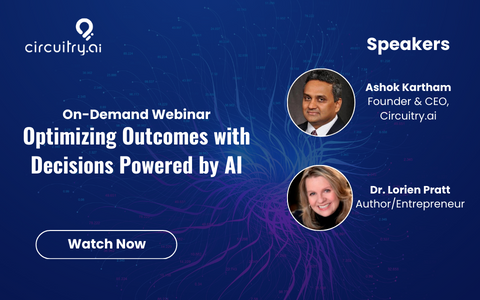 Decision Intelligence (DI) is quickly becoming an leading technology to help companies make better decisions. In a time where most organizations are wondering “How can AI help me?”, DI answers the question: it is considered by many to be a “last mile” that helps organizations connect AI to business outcomes and business decisions.
Decision Intelligence (DI) is quickly becoming an leading technology to help companies make better decisions. In a time where most organizations are wondering “How can AI help me?”, DI answers the question: it is considered by many to be a “last mile” that helps organizations connect AI to business outcomes and business decisions.
In this blog post, we want to share the review of the book by highlighting some of the core ideas.
DI is #2 on Alibaba’s list of top technologies for 2023 and the Gartner Group reports that 33% of large organizations used DI last year. So Pratt and Malcolm’s, "The Decision Intelligence Handbook: How Decision Intelligence Connects Data, Actions, and Outcomes for a Better World." (O'Reilly, 2023) couldn’t have come at a better time. It is a hands-on guide with step-by-step instructions and exercises that you can use “out of the box”. The book will tell you how begin with business goals and to work towards better data- and evidence-based solutions that integrate multiple state-of-the-art technologies.
Defining Decision Intelligence
The handbook begins by defining a “Decision” as a choice of actions that lead to outcomes. It shows how a diagram that connects actions to outcomes can also be used to determine the best role for data, AI, and human expertise.
This focus on action and outcomes is a common thread throughout the book, making it a general-purpose guide for implementing practical applications of DI across various domains, whether they are health care, climate, manufacturing, transportation, finance, or many more.
The Role of Casual Decision Diagrams
The backbone of the handbook is nine DI "best practice" processes for organizational decision making. One of the most important skills you will learn is to draw a “Causal Decision Diagrams (CDD)”, which can be useful even without any technology at all, because it aligns your team around a diagram showing the causal relationships between different actions, outcomes, and "externals": factors that you can measure and which — although you can’t change them — nonetheless affect your outcomes. Examples of this are the weather or the price of your competitor’s product.
The handbook shows how the CDD goes beyond just a diagram to also show how technology like simulation, data, and AI help to make better decisions. Indeed, the authors describe Decision Intelligence as a "hybrid" AI method that combines multiple tools so that decision makers can leverage data-driven insights, predictive modeling, optimization algorithms, and real-time decision support to enhance decision-making processes and improve decision outcomes.
Large Language Models and Generative AI
The book also describes how Large Language Models (LLMs) and Generative AI can work alongside decision intelligence in two ways: first it can help you to think of actions and outcomes that you may not have considered. Second, LLMs can act as a user interface to computerized DI/AI systems, effectively “unlocking” the power of all of the DI and DI-related technologies, including the intelligence that’s otherwise unavailable in your organization’s text documents.
Pratt and Malcolm write that, "Effective Decision Intelligence boils down to helping human decision makers (1) map the causal pathways between actions and their outcomes, (2) use this mapping to find the right data and knowledge to more accurately compute the expected outcomes corresponding to any set of actions, and then (3) use the computer to help find the best actions to take in a particular circumstance."
Decision Intelligence Use Cases
Unlike many books in the AI and tech space, the DI handbook provides numerous practical examples of application across various domains, including business, finance, healthcare, public policy, and environmental conservation. These case studies illustrate the benefits of DI, such as improving decision accuracy, enhancing operational efficiency, and driving innovation.
We highly recommend this book for anyone seeking a comprehensive guide to navigating the complexities of decision making in the transformative era fueled by AI. On reading the book, you’ll learn the details the core DI processes, including Decision Design, Framing, Modeling, Simulation, Assessment, Monitoring, and decision Review. Together, these processes will improve your business outcomes by applying advanced technology within your organization for maximum benefit.
At Circuitry, we are proud to announce that the first author of the DI Handbook, Dr. Lorien Pratt, has recently joined us as a Decision Intelligence advisor. Please learn more about DI on our upcoming webinar, "Optimizing Outcomes with Decisions Powered by AI," hosted by Circuitry.ai on March 12, 2024. You have a chance to win a digital version of the DI Handbook by registering for the webinar. Join the webinar to learn how you can apply Decision Intelligence to optimize your business outcomes.
Watch the webinar today and learn how you can apply Decision Intelligence to optimize your business outcomes.
